Mary de Cervellione facts for kids
Quick facts for kids SaintMary de Cervellione |
|
|---|---|

Stained glass window of the saint
|
|
| Born | 1 December 1230 Barcelona |
| Hometown | Barcelona |
| Died | 19 December 1290 Barcelona |
| Venerated in | Roman Catholic Church |
| Canonized | 15 February 1692 by Pope Innocent XII |
| Major shrine | Basilica of Our Lady of Mercy |
| Feast | 19 September |
| Attributes | Lily, boat, stormy sea |
| Patronage | Navigators |
Mary de Cervellione (also known as Maria de Cervelló) was a Catholic saint from Barcelona, Spain. She was born in 1230 and died on September 19, 1290.
Mary was a leader of a group of women called the Mercedarians. This group helped people who were captured or enslaved. After her death, many people honored her. The Catholic Church officially recognized her as a saint in 1692.
People often pray to Saint Mary de Cervellione to protect them from shipwrecks. She is usually shown holding a small ship. Her special day is celebrated on September 19. Because she was so kind to those in need, people called her "Maria de Socos," which means "Mary of Help."
Contents
Her Life and Work
Mary de Cervellione was born in Barcelona. Her father was a Spanish nobleman. She was baptized on December 8 at a church called Santa Maria del Mar.
Helping Others in Barcelona
Mary spent time helping at the Hospital of Saint Eulalia. This hospital was built with money from a rich businessman named Raimundo de Plagamans. It was located near the sea in a town called Villanova.
Joining the Mercedarians
The Mercedarians were a group that worked to free Christian people who were captured. These captives were often held by groups in Spain and North Africa. While working at the hospital, Mary met Peter Nolasco, who started the Mercedarian group.
One day, Mary heard a sermon that deeply moved her. She decided she wanted to do everything she could to help those who were captured. Her family tried to arrange a marriage for her, but Mary wanted to dedicate her life to helping others.
Starting a New Community
In 1265, Mary joined a small group of religious women. They lived near the Mercedarian monastery. These women spent their lives praying and doing good deeds.
They received permission to form a special group called the Third Order of Our Lady of Ransom. They wore the same clothes as the Mercedarian brothers. Besides their usual promises, they also promised to pray for Christian captives. Mary was chosen as the first leader of this new group.
A Life of Service
Even though the sisters prayed a lot, they were not a group that stayed hidden away. Mary de Cervellione continued her work at Saint Eulalia's Hospital. This hospital was a place where freed prisoners stayed when they returned home.
Because she cared so much for the poor and those in need, she was known as "Maria de Socos" (Mary of Help). People believed that she helped ships in danger at sea. This allowed them to safely bring Christian prisoners home.
Mary de Cervellione passed away on September 19, 1290.
Becoming a Saint
Mary de Cervellione's special honor as a saint was officially approved by Pope Innocent XII in 1692. Her body rests in the Basilica of La Merced in Barcelona. When you see pictures of her, she is often shown holding a ship.
See also
 In Spanish: María de Cervelló para niños
In Spanish: María de Cervelló para niños

